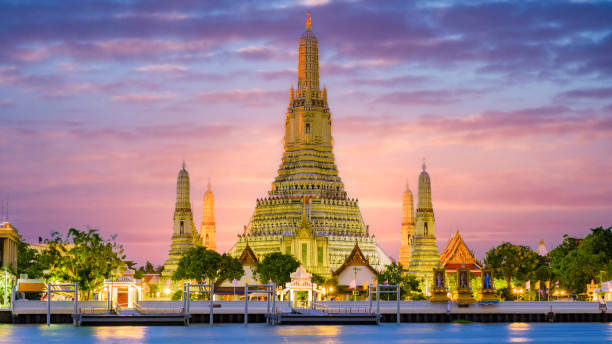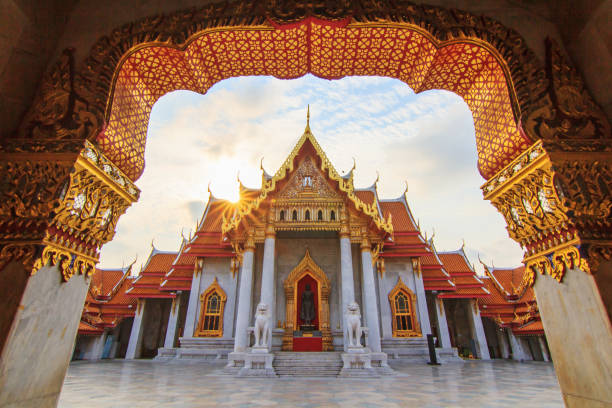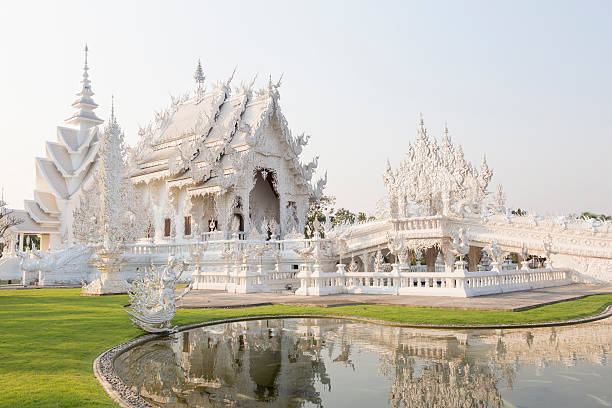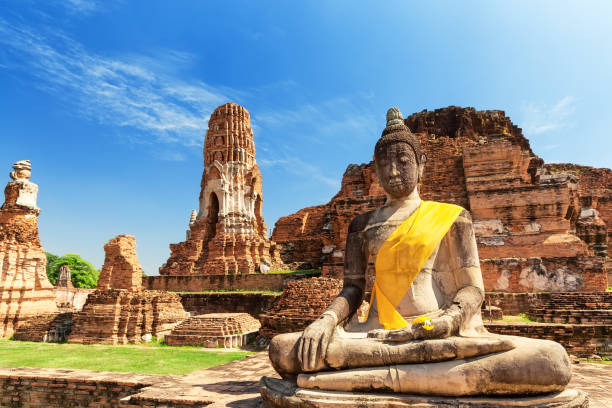Doing Thailand temple tour welcomes you to their intriguing world of history. This enchanted land’s rich cultural heritage and spiritual soul await you as you embark on a fascinating tour. The purpose of the Thailand temple tour is to take visitors on a fantastic adventure to some of the country’s most famous and stunning temples, where ancient rituals and modern life coexist harmoniously.
As we go along with this post, we will discover some of Asian’s wonders through the natural and fascinating temples in Thailand.
Thailand Temple Tour: A Guide to Thailand’s Wonders
Prepare to be awed as you explore a world of stunning buildings, tranquil temples, and exciting Buddhist rituals. All the different temples we see have fascinating backstories that shed light on their respective countries’ religious and cultural values. Here are just a few of Thailand’s most well-known temples.
Wat Arun (Temple of Dawn)
One of Bangkok, Thailand’s most recognizable landmarks, is Wat Arun, often known as the Temple of Dawn, located on the banks of the Chao Phraya River. Because of its towering spires and ornate design, it is one of the most visited temples in the country. The temple is called “Wat Arun,” meaning “Temple of Dawn,” because of the hypnotic beauty it supposedly exudes at sunrise.
The temple’s silhouette against the dawn sky is a beautiful sight. However, it retains its allure whether viewed during the day or the night. The centerpiece of Wat Arun is the prang, a tall tower-like structure covered in intricate flower patterns made from colorful porcelain tiles and seashells. At a height of about 79 meters (260 feet), the prang is easily visible against Bangkok’s cityscape.

Climbing the prang is an exciting adventure. Steep stairways lead visitors to different levels, each boasting breathtaking vistas of the river and its environs. When you reach the upper levels, they reward you with ornate decorations and statues depicting mythological figures.
In addition to the central prang, Wat Arun also features several subsidiary prangs, pavilions, gardens, and a courtyard. The Buddhist temple complex is a hub of worshippers who come to pay their respects and participate in religious ceremonies. Getting to Wat Arun from the Thai Tien Pier requires either a ferry ride across the Chao Phraya River or a picturesque river cruise that stops at several temples.
Wat Arun is worth visiting for its spiritual ambiance, the exquisite works of Thai artisans, and the breathtaking river and city vistas. This is one of Thailand’s most stunning temples, and it’s well worth the trip for anyone interested in Thai culture and architecture.
Wat Phra Kaew (Temple of the Emerald Buddha)
The temple is an impressive architectural feat of Thai craftsmanship. As you enter, it greets you with magnificent gates and buildings adorned with intricate carvings, colorful mosaics, and shiny gold accents. There is a combination of Thai, Khmer, and European architectural styles to breathtaking effect.
Wat Phra Kaew is famous for housing the Emerald Buddha. A single block of jade builds this small but highly revered structure. The Emerald Buddha, an invaluable cultural artifact in Thailand, revered its reputed good fortune. Different ceremonial garb dressed the statue, housed in an ornate ubosot (ordination hall) high above the ground, at other times of the year.
Several structures in the temple complex house priceless religious artifacts and which cater services for royal and religious ceremonies. Among these are the Phra Mondop library and the golden chedi (stupa) that houses the royal ashes of Thailand. If you go around the temple grounds, you’ll find a variety of beautifully decorated pavilions, statues of mythological creatures, and peaceful courtyards surrounded by verdant landscaping.
Murals depicting Buddhist stories and teachings adorn the walls of neighboring buildings, providing a window into Thai mythology and history. Wat Phra Kaew is a temple in Thailand of great historical and cultural value. Locals and visitors gather there to meditate in the peaceful atmosphere and offer prayers and pilgrimages, respectively. Cover your shoulders and knees and avoid wearing revealing clothing if you visit Wat Phra Kaew. Behaving respectfully includes not taking photos or making excessive noise in restricted areas.
Seeing the intricate artwork, devotion, and spirituality intertwined with Thailand’s history at Wat Phra Kaew will give you a fuller picture of Thai culture. Anyone curious about Thailand’s past, art, and architecture should go here.
Wat Pho (Temple of the Reclining Buddha)
The Reclining Buddha, one of the nation’s most enormous and gorgeous Buddha statues, resides there. As you enter Wat Pho, a quiet and sizable temple complex with magnificent gardens, intricate stupas, and rich architectural components will welcome you.
The Reclining Buddha statue, which stretches an impressive 46 meters (151 feet) in length and 15 meters (49 feet) in height, is Wat Pho’s main attraction. Gold leaf covers the statue and has intricate mother-of-pearl inlay at its feet, depicting auspicious symbols. The statue’s massive size and meticulous detail make it a stunning sight.
If you wander the temple grounds, you might find some other cool stuff—the complex houses over a thousand Buddha statues. Beautifully decorated chapels, skillfully carved gables, and vibrant murals depicting Buddhist stories and teachings await your exploration.
It is also the site of traditional Thai massage and was the first public institution in Thailand. Within the temple complex is a world-famous Thai massage school where you may have a genuine and rejuvenating massage. The well-maintained gardens, stone statues, and shaded courtyards create an ideal quiet contemplation and relaxation setting.
Wat Pho is a great place to learn about and immerse yourself in Thai religion, history, and culture. Both locals and visitors flock to this holy site to pay their respects, offer prayers, and seek blessings. With its enormous Reclining Buddha and peaceful ambiance, Wat Pho is one of Bangkok’s most popular tourist destinations.
Wat Benchamabophit (The Marble Temple)
Wat Benchamabophit, often known as the Marble Monastery, is a magnificent Buddhist temple in Bangkok, Thailand. Graceful architecture and superb craftsmanship have made this temple one of the most well-known and eye-catching in the country. King Rama V had Wat Benchamabophit built in the late 19th century. It is a fine example of the harmonious combinaton of how Thai and European architectural styles work. An imported Italian Carrara marble used to adorn the temple’s facade give it a one-of-a-kind radiance.

On entering the temple grounds, a beautifully landscaped courtyard adorned with white marble columns and lush vegetation will greet you. Worshipers can enter the temple’s ubosot or ordination hall from the yard. The intricate carvings and careful attention to detail on the ubosot are examples of the high quality of Thai craftsmanship. The gold-leafed, arched roof is the building’s most eye-catching feature. A serene and peaceful atmosphere are the results of the polished marble floors and ornate furnishings.
The ubosot’s focal point is a gilded Buddha statue. The Phra Buddha Chinnarat is a copy of the original Buddha image revered in Phitsanulok province. As a sacred place of prayer, it draws worshippers in search of divine favor and solace.
The temple complex also houses the ordination hall, prayer halls, and pavilions. These structures often feature elaborate woodwork, fresco paintings, and statues of mythical beasts. It is a tranquil haven in the middle of Bangkok where visitors can learn about Thai Buddhism. Wat Benchamabophit is a must-see in Bangkok for anybody interested in architecture, spirituality, or aesthetics.
Wat Phra That Doi Suthep (Temple of the Emerald Buddha)
The Wat Phra That Doi Suthep is a majestic Buddhist temple on the Doi Suthep mountain just outside of Chiang Mai in northern Thailand. Its perch on the hill offers breathtaking panoramas of the metropolis and its environs. There’s a report that a white elephant carrying a Buddha relic aimed to have mounted the mountain, circled, trumpeted three times, and then laid down to die softly.
Visitors can either utilize a funicular tram or climb the 309-step Naga staircase, which magnificent serpent-like animals ornamented it, to arrive at Wat Phra That Doi Suthep. As you climb higher, the lush flora and chiming bells will help you achieve a state of mind that is both peaceful and spiritual.
When you reach the peak, you’ll see the temple’s centerpiece: a stunning golden chedi (stupa). The chedi’s gold exterior shines wonderfully in the sunlight. The belief in having a Buddha relic makes it one of the holiest sites in northern Thailand.
Numerous structures and statues on the vast Wat Phra That Doi Suthep temple grounds attest to the long history of Thai Buddhism. Intricate carvings, golden parasols, and vivid paintings depicting moments from the Buddha’s life adorn the inside walls of this building. Enjoy scenic vistas of Chiang Mai and the surrounding area from this vantage point. At dawn and dusk, the scenery is breathtaking.
Wat Phra That Doi Suthep holds great religious and cultural significance for Thai people. Both locals and visitors flock there to show their respects, earn good karma, and get divine favor. Spirituality and the stunning natural beauty of northern Thailand are on display for visitors at Wat Phra That Doi Suthep. The temple’s spiritual significance, architectural beauty, and breathtaking scenery make it an essential stop for any traveler exploring Chiang Mai’s cultural treasures.
Wat Rong Khun (The White Temple)
Wat Rong Khun, popularly known as the White Temple, is a contemporary and atypical Buddhist temple in Chiang Rai, Thailand. Its striking white facade, ornate artwork, and unique architectural style have made it famous. Famous Thai artist Chalermchai Kositpipat combined modernist techniques with traditional Buddhist elements to construct the stunning Wat Rong Khun. They painted the entire building in white to represent innocence and decorated with glass mosaics that reflect and sparkle in the sunlight.
The bridge represents the threshold between the mundane world and spiritual awakening. Both sides of the bridge feature skeletal hands and devils reaching out, symbolizing the endless cycle of desire and temptation. The Ubosot, the main prayer hall, is the first thing you’ll see as you enter the temple grounds.

Intricate sculptures and paintings that combine traditional Buddhist imagery with more contemporary depictions, such as those of comic book heroes, Hollywood actors, and other cultural icons cover the building’s exterior. The frescoes in this room depict images from Buddhist mythology and paradise and hell as imagined by the artist. At the room’s center is a massive golden Buddha statue.
Artwork by Chalermchai Kositpipat, whose ideas inspired the construction of the White Temple, can be shown at the gallery adjacent to the Ubosot. Wat Rong Khun is notable for more than just its outlandish and controversial architecture. The temple’s murals feature political and social criticism that speaks to contemporary issues and moral quandaries.
Visiting the White Temple is an extraordinary opportunity beyond the typical temple experience. It provokes contemplation of the interconnectedness between art, spirituality, and the natural world. When visiting a Thai temple, it is respectful to dress modestly, covering your shoulders and knees. Its imaginative and cutting-edge layout creates an unforgettable adventure that inspires and enlightens visitors.
Wat Chedi Luang (The Temple of the Golden City)
It is renowned for its massive chedi (stupa), which was formerly one of the tallest structures in the ancient Lanna Kingdom. Construction on Wat Chedi Luang began in the 14th century and continued until the 15th. Before an earthquake in the 16th century partly destroyed the temple, the chedi (from which the temple gets its name) reached a height of about 82 meters (269 feet). Damage or not, the building is nevertheless an impressive testament to the architectural prowess of its day.
It is the focal point of worship and ceremonies because of the widespread belief that it houses Buddha’s remains. The vihara, the temple’s main assembly hall, can be found right beside the chedi. This hall has many Buddha statues, including the famous Phra Chao Attarot (the Crystal Buddha). The vihara’s beautiful architecture and intricate wood carvings result from combining Lanna and Burmese creative traditions.
Within the temple grounds, in a smaller chedi known as “Chedi Suwan Chang,” are the remains of a much-loved white elephant that previously called Chiang Mai home. It is a major center for Buddhist study and practice. Therefore, people from all over the world come there for enlightenment and spiritual guidance.
It becomes a popular tourist spot where visitors may see ancient buildings and relax in a serene setting. If you plan on visiting Wat Chedi Luang, please dress appropriately. Covering one’s shoulders and knees is customary when entering a Thai temple.
Wat Chedi Luang is a symbol of Chiang Mai’s rich cultural history. The enormous chedi and fine architectural features look for the glory of the ancient Lanna Kingdom, making this site an absolute must-see for anybody exploring the cultural riches of northern Thailand.
Wat Mahathat (The Temple of Mahathat)
The Ayutthaya Kingdom’s administrative and religious activities revolved around Wat Mahathat; a temple built in the 14th century. “Mahathat,” which translates to “Great Relic,” is the temple’s name because it houses an artifact widely believed to be a fragment of Buddha’s bone or teeth. A tall pagoda in traditional Khmer design, or the prang is the focal point of Wat Mahathat. As a temple symbol, the prang stands out for its ornate design and stacked spires. Even though wars and natural calamities have devastated the prang throughout the years, the remnants nonetheless exude a feeling of grandeur and historical significance.

This fascinating view has become a symbol of Ayutthaya, and tourists frequently stop to snap photos of it. It is part of the temple’s allure and mystery that nobody seems to know where the Buddha’s head came from or how it became intertwined with the tree. Old stupas, Buddha statues, and crumbling buildings litter the temple grounds. The tranquil setting and historical landmarks give guests a glimpse into Ayutthaya’s glorious past.
Wat Mahathat, an ancient Thai temple, is now recognized as a World Heritage Site by UNESCO. The ruins of the Ayutthaya Kingdom have retained the kingdom’s rich cultural history and architectural grandeur. Wat Mahathat is the best place to learn about Ayutthaya’s past and present, spirituality, and culture. You can think about how a once-great civilization fell and how the Thai people have managed to keep their culture alive and well despite the passage of time.
These are but a sampling of the many Thai temples waiting to be discovered. Visitors can gain insight into the spiritual and historical background of the country by exploring the various temples, each of which has its unique beauty, architectural style, and cultural value.
Frequently Asked Questions
Q: How much does it cost to visit Thailand’s Golden Temple?
A: The lap is seven cubits, one khuep 9 inches in height and six cubits 5 inches in width. Daily hours are from 8 a.m. to 5 p.m. There is a 40 baht entry fee.
Q: When visiting the temple, is it acceptable to wear shorts?
A: As a rule, denim is not allowed in temples. Women are not permitted to wear short shorts or miniskirts.
Q: If I visit a Thai temple, may I wear jeans?
A: Men are welcome to wear shorts in Thai temples. There is no need to wear anything over your knees. Long pants or jeans are acceptable alternatives, although the heat makes shorts more practical. Footwear – Shoes are required to be taken off before entering most of the temples in Thailand.
Q: In the temple, what is strictly forbidden?
A: Don’t bother touching any monuments or shrines. Stay away from cameras as well. Many religious buildings have rules against taking photographs. Please check the temple’s rules regarding photography before doing so. You can read the rules posted outside the building or inquire with an authority figure like a priest.
Q: What should one do before visiting a sacred shrine?
A: Behave yourself and always show proper reverence; Hindu temples are holy sites. Before entering the temple, it is recommended that you shower or bathe. Both men and women should dress modestly and conservatively when visiting a temple; traditional Indian garb is not required.
Final Thoughts
The Grand Palace, the tranquility of Wat Phra Kaew, and the creative marvels of Wat Arun are just a few of the temples that tell a different story and leave an indelible impression of Thailand. These temples’ bright colors, ornate patterns, and solemn atmosphere offer insight into the Thai people’s firmly held traditions and beliefs. Going to these sacred sites is a great way to learn about Thailand’s history and religious devotion and inspire reflection and spiritual connection. Whether seeking enlightenment, cultural exploration, or just a moment of serenity, the Thailand temple tour will be an unforgettable and transformative experience.
